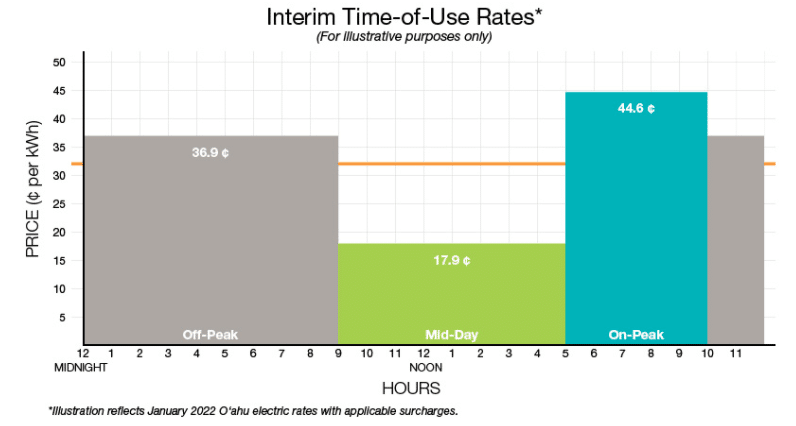California, long a leader in rooftop solar, is now wrestling with the complications — as illustrated by the current debate over the California Public Utility Commission’s proposed decision on “net energy metering 3.0,” released last month. Before the end of 2021, we began a series of blogs looking closer at this issue by noting that much of the publicdebate over the proposed decision has focused on the new “grid participation charge,” which would be structured as a monthly fee per kW of installed capacity.
Another issue under consideration, on which we’ll focus in this second installment, is time-of-use (TOU) rates. Getting TOU rate design right should be emphasized both in the short term — as an alternative to a large grid participation charge — and in the context of longer-term rate design reform. In short, ensuring that TOU rates for new DER customers have sufficiently low daytime prices is likely to be a more economically efficient way to reduce cost shifts.
The proposed decision does have a brief discussion about the importance of bigger on-peak/off-peak price ratios in TOU rates, and it imposes a requirement that new solar customers go onto such a rate. The proposed decision lists an existing rate that qualifies for each of the three investor-owned utilities, but it does not show those rates or discuss their structure. Those rates are:
- The EV2-A rate for Pacific Gas & Electric (PG&E);
- The EV-TOU-5 rate for San Diego Gas & Electric (SDG&E); and
- The TOU-D-PRIME rate for SoCal Edison (SCE).
These rates do have a bigger on-peak/off-peak price ratio than other TOU rates available in California, but that should not be the only consideration in the construction of a fair and efficient TOU rate. The time period structure, namely the hours that are on-peak, off-peak, and other designations, and the relative levels across each period are all important as well. The 2021 PG&E EV2-A rate in the summer is shown in Figure 1.
Figure 1: PG&E Summer Price Structure Under the EV2-A Rate in 2021

Under any DER compensation structure where a customer can reduce their bill with lower imports from the grid, a substantial portion of the compensation for installing solar will come from the retail rate during daytime hours. As shown in Figure 1, that rate was 19 cents per kWh for PG&E in 2021 and is now 21 cents in 2022. Under the SCE TOU-D-PRIME rate, the daytime kWh rate is 19 or 20 cents per kWh, depending on the season. The SDG&E EV-TOU-5 rate has a more complex structure, but in the summer the daytime kWh rate is even higher, now at 39 cents per kWh in 2022. To the extent that solar customers are overcompensated, and thus causing costs to be shifted unfairly to other customers, this would be a major reason why. If the daytime kWh rate can be reasonably lowered, it could address a substantial portion of any cost shifting and substitute for other potential charges on DER customers, such as the grid participation charge.
The goals of TOU rate design are much the same as all rate design, and indeed utility regulation generally. The desire of economic efficiency must be balanced with the need for customer understanding, costs must be allocated equitably across all customers, and overall revenue levels must provide the utility a reasonable opportunity for a fair rate of return. Compared to flat volumetric kWh rates, TOU rates are attempting to better correspond to predictable fluctuations in the marginal costs, both short- and long-run, of the electric system. Seasonal distinctions can also be important in a TOU rate structure, although such distinctions are possible in simpler rates.
In California and other states where solar is a major part of the resource mix, a particular pattern for marginal costs (in this context, referred to “avoided costs”) is emerging. A longstanding process at the CPUC has led to the annual submission of an “Avoided Cost Calculator” by the consulting firm E3. While the 2021 ACC shows an avoided cost pattern for 2022 that roughly tracks PG&E’s EV2-A rate, by 2024 a different pattern starts to emerge. The daytime hours start to have distinctly lower avoided costs and this trend grows over time. An efficient TOU structure will track these avoided cost patterns with lower prices during daytime hours.
Why does the cost structure expected in California in a few years matter for rate design today? First, anticipating where rate design needs to go in the future is helpful for considering changes over time. Many solar programs have guaranteed customers that they can stay on a particular rate structure for a given period of time to avoid adverse financial impacts. Under those circumstances, it would be wise to implement a rate structure that reflects expected conditions in the future.
Second, these particular rates drive much of the other analysis in the proposed decision about cost shifting, as well as the grid participation charge and the market transition credit. For example, a major reason that SDG&E customers do not get a market transition credit under the PD is likely that the high daytime kWh price in the summer that provides much of their compensation is so generous. If a new rate with lower daytime prices were to be implemented in two years and new solar customers were required to go on that rate, it would upend all of the analysis that went into structuring the grid participation charge and market transition credits.
A third, perhaps more technical, reason is that when you are structuring cost recovery, the relative price elasticity of demand can be considered. As solar costs have declined, overall daytime net consumption has become more elastic (e.g., readily responsive to prices) exactly because of the option to install solar. This reason alone may be sufficient to get out in front of these issues and reallocate revenue collection away from daytime hours to other parts of the rate. This shows why changing TOU rate structures, particularly with lower daytime prices, is a superior option to the grid participation charge. Hawaiian Electric has already structured some of its TOU rates to have the lowest prices in the daytime, as shown in Figure 2.
Figure 2. Hawaiian Electric Residential TOU Rate for January 2022

While both methods can correct for a cost shift in a spreadsheet model, the grid participation charge is likely to push customers to shrink their solar systems and, even worse, avoid interaction with the grid. A lower daytime price, on the other hand, helps shift load — particularly flexible loads like EVs and battery storage — to the daytime when generation resources are expected to be abundant and relatively low-cost. This is why rate design was one of RAP’s strategies for Teaching the Duck to Fly.
It is important to note that the correct daytime price for these rates should not necessarily drop all the way to the 3-4 cents of avoided costs shown in the E3 avoided cost calculator. First, an extraordinarily low price in the daytime would by itself undercut the economics of solar installations, so the impact on adoption rates should be considered. Second, an extraordinarily low price in the daytime might spur a customer overreaction — moving significantly more consumption than might be expected to the daytime. As a result, the principle of gradualism likely dictates that the pace of change should be moderated appropriately.
Furthermore, the E3 avoided cost calculator has many good features, but it likely does not include full long-run marginal costs for delivery. For example, one expert, testifying in the NEM 3.0 docket on behalf of agricultural electricity consumers, argued that current methods ignored the long-run marginal cost of new transmission needed to deliver utility-scale generation and estimated that marginal cost at 3.75 cents per kWh. Including this type of marginal cost is crucial to establish fair competitive terms between utility-scale solar and local resources. Otherwise, the scale is unfairly weighted towards the side of utility-scale resources. While the E3 avoided cost calculator indicates that there are marginal costs for transmission capacity in the evening peak hours, there are no marginal transmission capacity costs in the daytime hours. If that is the case, this would indicate an issue that should certainly be explored and corrected in the future.
Unfortunately, changes to TOU rate structures were not considered at all in the proposed decision and were not raised prominently in the docket. The solar industry and its allies worry that creating new rate designs that only apply to solar customers risks unfairly singling them out. RAP believes that any new rate structures should be fairly and efficiently designed and should be technology-neutral in order to be applied to a broad swath of customers. On the other side, the utilities focused on their proposal that became the grid participation charge, an option that appears to be unfair and inefficient. If the CPUC declines to adopt the current proposed decision, restructuring the TOU rates would be a sensible option to put on the table, along with other options discussed in our first blog in this series. At a minimum, considering how future reforms to TOU rate structures would require changes to the grid participation charge is necessary.
Forward-looking TOU rates that include lower daytime prices offer an opportunity to advance NEM reform goals while improving customer incentives. More generally, technology-neutral rate design reforms should be the path forward, not the arbitrarily sized installed capacity charges designed to claw back revenue in the proposed decision.

